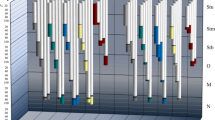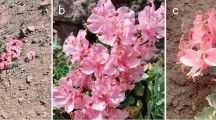Abstract
Key message
The olive tree response to sequential pollinations is a more accurate procedure in the assessment of effective pollination period and flower life span than procedure based on the calculation of the components of the pollen-pistil interaction.
Abstract
Effective pollination period (EPP) was defined by Williams (1965) as the period during which pollination can result in fruit set. EPP was proposed to be the time the ovules remain fertile minus the time needed for a pollen tube to reach the ovule, providing that this value does not exceed the length of stigma receptivity. The duration of the EPP in fruit trees can be estimated by the microscopic analyses of these three components, but also by the plant response to sequential pollinations in term of fruit set. Here, we compare the estimation of EPP duration under cross-pollination in the main olive cultivars (Olea europaea L.) grown for oil production in Croatia (‘Lastovka’, ‘Leccino’, and ‘Levantinka’) based on these two procedures to discuss the advantages and disadvantages of each estimation and propose the best methodology to assess EPP duration and the capacity of flowers of different age to set fruit. Our comparison highlights that the different procedures provide a contrasting duration of EPP in all olive cultivars here analyzed. EPP based on initial fruit set and final fruit set was between 2 and 3 days, while that based on the microscopic study of EPP components was between 5 and 12 days, depending on the cultivar. We defend that EPP based on fruit set is more accurate and more relevant for growers, and believe that the longer duration of EPP when the estimation is based on the study of the components could be due to wrong assessments of the duration of particular components. In this sense, pollen germination may be a better parameter than pollen adhesion to estimate stigma receptivity. Ovule longevity assessment based on the fluorescence emitted could be an overestimation of the actual ovule readiness for fertilization. Style suitability, not considered in Williams’ equation, plays an important role supporting pollen tube growth toward the ovules and might be also relevant in determining EPP duration.




Similar content being viewed by others
References
Arzani K, Javady T (2002) Study of flower biology and pollen tube growth of mature olive tree cv. ‘Zard’. Acta Hortic 586:545–548
Bini J (1984) Fioritura e impollinazione nell’olivo. Indagini sul periodo d’impollinazione, recettivitta dello stigma ed evoluzione del gametogito femmenile. Riv Ital Ortoflorofrutticoltura 68:57–69
Cerović R, Ružić D (1992) Senescence of ovules at different temperatures and their effect on the behavior of pollen tubes in sour cherry. Sci Hortic 51:321–327
Cerović R, Ružić Đ, Mićić N (2000) Viability of plum ovules at different temperatures. Ann Appl Biol 137:53–59
Cuevas J, Rallo L, Rapoport HF (1994a) Staining procedure for the observation of olive pollen tube behavior. Acta Hortic 356:264–267
Cuevas J, Rallo L, Rapoport HF (1994b) Procedure to study ovule senescence in olive. Acta Hortic 356:252–255
Cuevas J, Díaz-Hermoso AJ, Galián D, Hueso JJ, Pinillos V, Prieto M, Sola D, Polito VS (2001) Response to cross pollination and choice of pollinators for the olive cultivars (Olea europaea L.) ‘Manzanilla de Sevilla’, ‘Hojiblanca’, and ‘Picual’. Olivae 85:26–32
Cuevas J, Pinillos V, Polito VS (2009) Effective pollination period for ‘Manzanillo’ and ‘Picual’ olive trees. J Hortic Sci Biotech 84:370–374
González MV, Coque M, Herrero M (1995) Stigmatic receptivity limits the effective pollination period in kiwifruit. J Am Soc Hortic Sci 120:199–202
Lavee S (1986) Olive. In: Monselise SP (ed) Handbook of fruit set and development. CRC Press, Boca Raton, pp 261–276
Pinillos V, Cuevas J (2008) Standardization of the fluorochromatic reaction test to assess pollen viability. Biotech Histochem 83:15–21
Pinney K, Polito VS (1990) Olive pollen storage and in vitro germination. Acta Hortic 286:207–210
Polito VS, Pimienta E (1982) A rapid and accurate fluorescence method using ovule whole mounts to assess fertilization in plants. Mikroskopie 39:32–34
Postweiler K, Stösser R, Anvari SF (1985) The effect of different temperatures on the viability of ovules in cherries. Sci Hortic 25:235–239
Rapoport H, Rallo L (1991) Postanthesis flower and fruit abscission in ‘Manzanillo’ olive. J Am Soc Hortic Sci 116:720–723
Sanzol J, Herrero M (2001) The “effective pollination period” in fruit trees. Sci Hortic 90:1–17
Sanzol J, Rallo P, Herrero M (2003a) Stigmatic receptivity limits the effective pollination period in ‘Agua de Aranjuez’ pear. J Am Soc Hortic Sci 128:458–462
Sanzol J, Rallo P, Herrero M (2003b) Asynchronous development of stigmatic receptivity in the pear (Pyrus communis, Rosaceae) flower. Am J Bot 90:78–84
Sedgley M, Griffin AR (1989) Sexual reproduction of tree crops. Academic Press, London
Serrano I, Suárez C, Olmedilla A, Rapoport HF, Rodríguez-García MI (2008) Structural organization and cytochemical features of the pistil in olive (Olea europaea L.) cv. Picual at anthesis. Sex Plant Reprod 21:99–111
Stösser R, Anvari SF (1982) On the senescence of ovules in cherries. Sci Hortic 16:29–38
Tombesi A, Cartechini A, Preziosi P (1982) La interfertilita` fra le cultivar di olivo, Frantoio, Leccino, Maurino e Moraiolo. Annali della Facolta` di Agraria. Universita` degli Studi di Perugia XXXVI: 345–356
Tromp J, Borsboom O (1994) The effect of autumn and spring temperature on fruit set and on the effective pollination period in apple and pear. Sci Hortic 60:23–30
Vasilakakis MD, Porlingis IC (1985) Effect of temperature on pollen germination, pollen tube growth, effective pollination period, and fruit set of pear. HortScience 20:733–735
Villemur P, Musho US, Delmas JM, Maamar M, Ouksili A (1984) Contribution à l’étude de la biologie florale de l’olivier (Olea europaea L.): stérilité mâle, flux pollinique et période effective de pollinisation. Fruits 39:467–473
Vuletin Selak G, Perica S, Goreta Ban S, Radunic M, Poljak M (2011) Reproductive success following self-pollination and cross-pollination of olive cultivars in Croatia. Hortic Sci 46:186–191
Vuletin Selak G, Cuevas J, Goreta Ban S, Pinillos V, Dumicic G, Perica S (2014) The effect of temperature on the duration of the effective pollination period in ‘Oblica’ olive (Olea europaea) cultivar. Ann Appl Biol 164:85–94
Williams RR (1965) The effect of summer nitrogen applications on the quality of apple blossom. J Hortic Sci 40:31–41
Williams RR (1970) Techniques used in fruit-set experiments. In: Williams RR, Wilson D (eds) Towards regulated cropping. Grower Books, London, pp 57–61
Author contribution statement
G.V.S. and S.P. designed the experiments. G.V.S. and J.C. performed the research. S.G.B. and G.V.S. carried out analysis of data. G.V.S., J.C. and V.P. participated in interpretation of data. G.V.S. and J.C. prepared the manuscript. M.P., S.G.B. and S·P. critically revised the manuscript.
Acknowledgments
The authors would like to acknowledge the support of the Croatian Ministry of Science, Education and Sports (grant no. 091-0910468-0166) and the Croatian Ministry of Agriculture (V-16-7/04). We gratefully acknowledge the contributions of Ana Vidak and thank her for technical assistance.
Conflict of interest
The authors declare that they have no conflict of interest.
Author information
Authors and Affiliations
Corresponding author
Additional information
Communicated by J. Lin.
Rights and permissions
About this article
Cite this article
Vuletin Selak, G., Cuevas, J., Pinillos, V. et al. Assessment of effective pollination period in olive (Olea europaea) by means of fluorescence microscopy and plant response to sequential pollinations: limitations and drawbacks of current methodologies. Trees 28, 1497–1505 (2014). https://doi.org/10.1007/s00468-014-1053-7
Received:
Revised:
Accepted:
Published:
Issue Date:
DOI: https://doi.org/10.1007/s00468-014-1053-7




